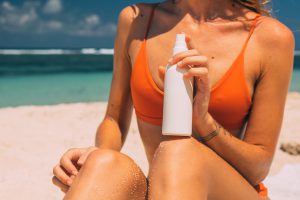Best Natural Sunscreens Money Can Buy!

This summer, mineral sunscreen is a must—it’s for the environment, your health, and to keep that youthful glow of your skin. Fortunately, technology has improved dramatically, so wearing it isn’t such a chore anymore!
Our favorites feel good on the skin and smell great too. Plus, they look gorgeous sitting in your bag – but most importantly, they work!
Best Options:
- The Best Refreshing Mineral Sunscreen
- Best Daily Sun Protection Mineral Sunscreen
- The Best Moisturizing Mineral Sunscreen
Why Choose Mineral?
When it comes to safe, clean sunscreen choices, all-mineral or physical sunscreens are the only way to go. These types of sunscreens contain zinc and titanium dioxide that create a barrier on top of your skin in order to protect it from UVA and UVB rays.
If you take a look at the “active ingredient” section on any other type of sunscreen product label; chances are they include chemicals that may not be as beneficial for your health!
Mineral sunscreens both provide broad-spectrum protection and do not penetrate our bodies, unlike chemical sunscreens. Chemical sunscreens absorb the UV rays of the sun while simultaneously entering directly into one’s bloodstream and include some of the most irritating elements in cosmetics.
Furthermore, they have been known to contain endocrine disruptors – such as oxybenzone – which is so harmful it has been prohibited in parts of Hawaii and other Caribbean locations due to its destructive nature on coral reefs.
Oxybenzone is a troubling chemical that has been linked to endocrine disruption, allergies, and other health issues. Additionally, it can be readily absorbed into our skin in large amounts, as studies have detected its presence in human breast milk, amniotic fluid, urine, and blood samples.
Furthermore, oxybenzone may also adversely affect the health of our marine ecosystem through contamination.
The Consumer’s Opposition
While greater awareness of chemical sunscreens and their potential for harming our health and the environment is leading to safer formulas, the sunscreen safety report shows that the use of oxybenzone is decreasing.
Last year it was featured in 60% of nonmineral suncreens – but this year, only 40 percent did! This demonstrates a promising shift towards providing safer alternatives for consumers when choosing protection from the sun.
Despite the advances in sunscreen products, three-fourths of the SPF items tested by the Environmental Working Group (EWG) this year failed to meet their criteria for a safe and efficient option. Out of 1,300 different sunscreens examined, only 25% passed the EWG’s standards.
At 100%Pure, safety and efficacy are the top priorities of all sunscreens sold. To make things even better, they curate their shop with advanced formulas that can be effortlessly applied while providing an added bonus such as a nice smell or fashionable design.

Face: Everyday Protection
Investing in mineral sunscreen is the wisest decision you can make to retain your youthful radiance. Find a formula that works best for you and engage in this beneficial habit daily; it’s worth every minute!
- Tinted Facial Mineral Sunscreen
- Moisturizing Mineral Sunscreen
- Lycopene SPF 20 Moisturizer
- Milky Mineral Sun Serum Spray SPF 50
Body: Sport and Beach Protection
Heavier formulas are perfect for covering your entire body, as well as withstanding sweat and water when engaging in outdoor activities.
For Kids
For babies’ tender skin, pick a fragrance-free formula that is gentle on their delicate complexion. Whereas for kids, it’s best to go with an easier-to-apply formula so they’re more likely to reapply when needed.
It is Not Enough Regulation
Although considerable progress has been made in improving sunscreen products, transitioning to the new rules is taking longer than expected.
Despite optimistic expectations that the FDA would finalize its proposed regulations for sunscreens by 2020’s end, American stores are still selling SPF items with minimal changes from years prior.
If approved, the FDA’s plan would have provided greater safety and effectiveness for all US sunscreen products. Yet in March, the CARES Act included a clause that paused immediate progress to pass and make official these proposed changes by the FDA.
The FDA has introduced a proposal to collect more data on the safety and efficacy of twelve chemical substances, as well as set SPF limits at 60 and above. Explaining that high-SPF products can lead customers to believe they are safe from sun damage when this is not necessarily true.
This cap could have bolstered the balanced protection provided by sunscreens. While a high SPF can shield you from UVB rays—the ones that cause tanning—they usually don’t provide satisfactory defense against UVA rays, which are linked to skin damage and cancer.
To ensure that US consumers receive the best possible protection against UVA rays, stringent measures were put in place. Unfortunately, these standards are still inadequate compared to those enforced by other countries like Europe; most sunscreen products sold here would not even pass their quality assurance tests.




